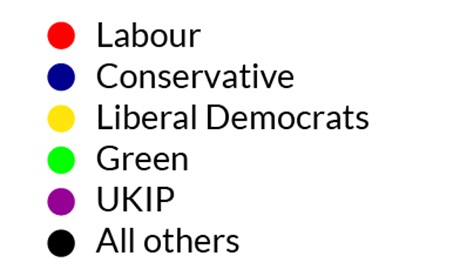Forecast: how East Londoners plan to vote on 7 May

(Photograph: Phillip Capper)
With the General Election campaign heating up, you may be wondering what is going through the minds of East Londoners as they orient themselves toward the polling station.
Gauging vote intentions at the level of parliamentary constituencies is a tricky business, as most public opinion surveys have too few respondents from each seat for meaningful conclusions to be extracted from the data. Bespoke constituency polls such as those carried out by Lord Ashcroft do offer such insights, but the intrepid polling peer has yet to venture into the east of the capital.
We can gain some purchase on the pre-electoral ruminations of East Londoners by examining data from the British Election Study, an academic survey that has fielded several questionnaires over the course of the past year. Their most recent data is from a survey carried out in September and October of 2014.


Solid Labour territory
East London is solid Labour territory; in 2010 the party easily swept all six seats included in this analysis (Hackney North & Stoke Newington, Hackney South & Shoreditch, Bethnal Green & Bow, Poplar & Limehouse, East Ham, West Ham, Leyton & Wanstead and Walthamstow).
It is thus not surprising that Ed Miliband’s party should remain the favourite in this area, with 54 percent support.
The second most popular option is the Conservatives (21 per cent), followed by the Greens (11 per cent), UKIP (8 per cent) and the Liberal Democrats (5 per cent).
Comparing these reported preferences with the average vote share of the same parties at the 2010 General Election, we see that Labour support has hardly budged from the 53 per cent achieved five years ago, and though the Conservative vote has risen a bit from 17 per cent in 2010, the most significant change is the precipitous decline of the Liberal Democrats, whose vote share has fallen in tandem with a dramatic increase in support for both the Greens and UKIP.
Taken together, these figures suggest that trends in East London are not so different from those in the rest of the country, though we appear to have experienced a somewhat larger Green surge and a proportionately smaller purple surge than elsewhere.
Of course intentions could change by May, but it appears unlikely that we will see Labour losing any of its East London safe seats.
At the same time, these data suggest that subtle shifts in party support are afoot, which may mean that in time we find different parties representing us, particularly at London and local levels.
The views and experiences of East Londoners give some clues as to why they plan to vote the way they do.
Asked what they thought about the spending cuts introduced by the Coalition government during its term in office, 64 per cent of the East Londoners polled said they thought the cuts had gone too far. This compares with just over half the overall UK population who held this view.
Views on redistribution tell a similar story, with 42 per cent of the residents of the east of the capital thinking the government should do more to reduce differences between rich and poor, as against only 37 per cent of the wider population.
Immigration is another topic on which the survey quizzed citizens. A total of 60 per cent of those in East London said they thought immigration enriches British society, compared to 35 per cent of the UK population overall. Only 23 per cent of those in East London blame immigrants for the UK’s economic problems, whereas 44 per cent of the UK population overall make this link.
Residents in this area also have distinctive views on the European Union, with 35 per cent in favour of further integration. By contrast, only 22 per cent of those in the wider UK community believe in closer union with the EU.
When queried as to whether their own personal economic circumstances had improved or declined over the past 12 months, 38 per cent of East Londoners said they were worse off than they had been a year previously, and only 21 per cent said they were better off.
The British Election Study thus paints a picture of an East London community that is open to the wider world and less likely than the rest of the UK to blame immigrants for economic problems.
Instead, East Londoners tend to blame the government’s recent policies for their economic woes. These findings help explain why local residents are likely to vote against the Coalition parties on 7 May.

